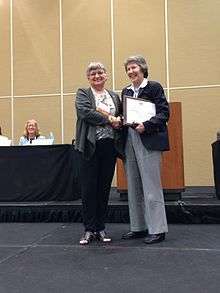Diane Gifford-Gonzalez
| Dr. Diane Gifford-Gonzalez | |
|---|---|
 SAA President Dr. Diane Gifford-Gonzalez (left) presenting the 2016 Society for American Archaeology's Fryxell Award to Dr. Elizabeth Reitz (right) | |
| Nationality | American |
| Awards | 2014 Martin M. Chemers Award for Outstanding Research in the Division of Social Sciences, 2013 Committee of Honor International Conference of Archaeozoology (ICAZ), 2013 Presidential Recognition Award (SAA), 2007-2011 Fulbright Senior Specialist, 2003 Distinguished Teaching Award, and 1995 Presidential Recognition Award (SAA) |
| Website |
anthro |
| Academic background | |
| Alma mater | University of California, Berkeley |
| Academic work | |
| Discipline | Anthropologist |
| Sub discipline | Zooarchaeology and African pastoralism |
| Institutions | University of California Santa Cruz |
Diane Gifford-Gonzalez is an American archaeologist who specializes in the field of zooarchaeology. Her research has included fieldwork near Lake Turkana that borders Kenya and Ethiopia, and her research often touches on the question of animal domestication.[1]
Biography
Gifford-Gonzalez is based out of the state of California, with a specialty in Zooarchaeology.[2] She attended the University of California-Berkley where she got her B.A., M.A., and her Ph.D.[2] Along with being President of the Society of Africanist Archaeologists, she has served on boards for that organization along with so many others, such as: the International Conference of Archaeozoology (ICAZ), the Society for American Archaeology (SAA), and the Archaeology Division of the American Anthropological Association.[2] She is currently the President-elect for the Society of American Archaeology.[2] She was also on the Academic Advisory Council of the Wenner-Gren Foundation for Anthropological Research and the Long-Range Planning Committee of the American Anthropological Association.[2] Plus, she is on the editorial boards for African Archaeological Review, Journal of African Archaeology, California Archaeology, and Teals d’Arqueologia.[2]
She has worked at universities in California (Santa Cruz), Nairobi, Tromsø, la Universidad del Centro de la Provincia de Buenos Aires, Argentina, and Academia Sinica, Beijing, China.[2] She retired from teaching at the end of the academic year in 2015.[2]
Research
Her work at Lake Turkana on the boarder of Ethiopia and Kenya has put her at the forefront of domestication of animals in that area.[1] She has found early evidence of fishers around Lake Turkana.[3] Fishing has typically been something associated with the Upper Paleolithic, Later Stone Age, and the Holocene; usually with anatomically modern humans.[3] She has found evidence that cattle domestication in the Eastern and Southern Africa was delayed by as much as a millennia past everywhere else in Africa.[4] This delay may have been due to disease of the cattle, such as Bovine Malignant Catarrhal Fever (MCF), which is almost 100% lethal for cattle.[4] Another problem she found was diseases affecting humans, such as the Rift Valley Fever (RVF).[4] She has also been apart of genetic testing of animals that can show where an animal was domesticated.[5]
Important writings
- Gifford-Gonzalez, Diane (1991) "Bones Are Not Enough: Analogues, Knowledge, and Interpretive Strategies in Zooarchaeology". Journal of Anthropological Archaeology. 10 (3)
- Gifford-Gonzalez, Diane (1998) "Early Pastoralists in East Africa: Ecological and Social Dimensions". Journal of Anthropological Archaeology. 17 (2)
References
- 1 2 Gifford-Gonzalez, Diane (1998). "Early Pastoralists in East Africa: Ecological and Social Dimensions". Journal of Anthropological Archaeology. 17 (2): 166–200. doi:10.1006/jaar.1998.0322.
- 1 2 3 4 5 6 7 8 "Diane Gifford-Gonzalez". University of California-Santa Cruz. Retrieved 2016-10-23.
- 1 2 Gifford-Gonzalez, Diane; Stewart, Kathlyn; Rybczynski, Natalia (1999). "Human Activities and Site Formation at Modern Lake Margin Foraging Camps in Kenya". Journal of Anthropological Archaeology. 18 (4): 397–440. doi:10.1006/jaar.1999.0337.
- 1 2 3 Gifford-Gonzalez, Diane (2000). "Animal Disease Challenges to the Emergence of Pastoralism in Sub-Saharan Africa". African Archaeology Review. 17 (3): 95–139. doi:10.1023/A:1006601020217.
- ↑ Gifford-Gonzalez, Diane; Hanotte, Olivier (2011). "Domesticating Animals in Africa: Implications of Genetic and Archaeological Findings". Journal of World Prehistory. 24 (1): 1–23. doi:10.1007/s10963-010-9042-2.